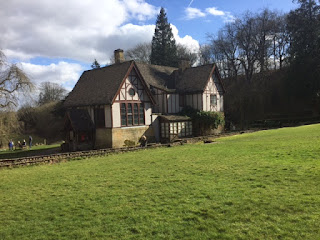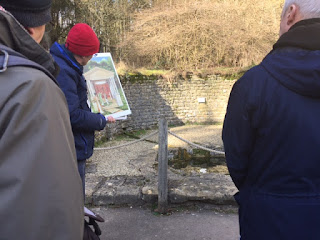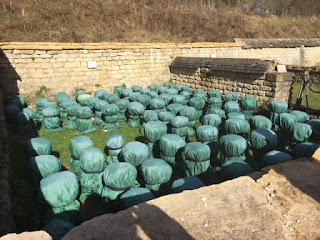Chedworth Roman Villa- Well-preserved Roman mosaic floor in the Tepidarium (warm room) of the villa.
Chedworth Roman Villa
Did you know that there are over 450 Roman villa remains in the UK? I did not know this. I very stupidly thought that about 20 Romans came over to Britain; a few of them stayed in London and built a couple of things there, a few went north to sort out Hadrian’s Wall, and a few went to Bath.
But I was wrong, as usual. A quick look on Wikipedia shows that even in my home county of Northamptonshire there are several villages that I thought were entirely featureless that actually have the remains of a Roman villa in them. Amazing.
Thanks to a lovely tour guide called Julian, I learned a lot more at Chedworth Roman Villa near Cheltenham today. We hadn’t planned to join a tour, but one was starting as we arrived so we tagged along expecting to wander off at some point. But an hour later, I was still hanging on Julian’s every word as he pointed things out that we would never have noticed without him. So Chedworth Tip One: join the tour.

1. Who discovered Chedworth?
The villa was discovered in 1864 by a man called James Farrer
His nephew owned the estate, and one day a gamekeeper found some tesserae (little cubes that were used to make Roman mosaics), which he showed to James
Jimbo wasted no time – he was a keen antiquarian and he soon had a band of men digging the place up
In one summer they uncovered pretty much everything that we see today
He built a museum in the middle of the excavated site on the spoils from the clearance – I was really disappointed by this, as I thought someone had accidentally built a house here and then discovered it was bang in the middle of a Roman villa. But no.

2. When was it built?
Some simple structures were built on the site in the 2nd century AD
From the 330s to the 380s, the villa was extended and had its heyday – the west range and north wing housed the main reception rooms, while the south wing was a service area with a kitchen and a toilet
But then in the early 5th century, Britain ceased to be part of the Roman Empire – the collapse of the Roman system brought the decline of luxurious villas like the one at Chedworth
The once beautiful, elegant rooms would have been used for keeping animals until eventually the buildings started to collapse and rot away
3. Who lived there?
The short answer: nobody knows
However, it would have been someone of consequence – it was a big, luxurious villa that would probably have been owned by someone involved in the administration of nearby Cirencester
Hairpins and children’s bracelets have been found, suggesting that a family lived there
4. What is there to see?
The outline of parts of the villa is visible – the Victorians used what stones were left to reconstruct the general footprint
The nymphaeum, or shrine to the nymphs, is situated in the top corner of the villa – Julian’s pictures came in handy at this point:

Good old Julian showing us what the shrine
would have looked like in the 4th century
But the real show-stopper is the mosaic work in the west range – the pictures below really don’t do it justice:

The huge mosaic in the dining room with its scantily clad ladies –
Julian got a lot of interest in those
 The west bath house
The west bath house
We also got to see the pilae that would have been used to create the hypocaust system for heating the rooms – they’re in their puffa jackets to protect them from the elements at the moment:

5. What didn’t we see?
Snails. Apparently the Romans liked eating snails and brought some of their favoured variety with them. A few plucky gastropods made a run for it and escaped the cooking pot, taking up residence in the vicinity AND THEY’RE STILL THERE TODAY! Not the same ones obviously, but their descendants continue to squelch their way around the villa 1700 years later.
More mosaics. Amazingly, some of the mosaics were covered over again post-excavation, as they’d be destroyed if left open to the elements. So you walk round on grass verges knowing that there are stunning patterns beneath your feet.
I was very disappointed by the lack of scones but let’s be clear; this was scone mission #153. My rough guess is that of 153 properties visited, only five have failed to deliver scones when I would have expected some to have been available. That’s not too bad.
Anyway. I had dragged the Sidekick some distance and we were both hungry, so he had carrot cake and I had fruit cake. And they were both DELICIOUS.

I was so disappointed that I couldn’t even be bothered to turn it the right way up
for the photo. Then I tried it and it was absolutely lovely.
I’ve been pretty lucky with this Scone Odyssey so far. Every time a scone fails to materialise or impress, the property turns out to be brilliant – see also Penrhyn Castle and Coleton Fishacre. With 100 properties left to go, long may that continue.
Finally – a word about guided tours at the NT. I rarely join them and I really don’t know why, because they are always useful. Red House, Acorn Bank, Quebec House – all of these properties were brought to life by an NT tour guide. So take my advice, readers: IT’S NOT A CHORE, SO DO THE TOUR. (You can have that for free, National Trust marketing team.)
Related Post
A shocking documentary proves that mermaids do exist
SHOCKING Revelation: Thuya, Mother of Queen Tiye, Was the Grandmother of Akhenaten and Tutankhamun—What Ancient Egyptian Secrets Did She Leave Behind?
Breaking News: Astonishing Discoveries at Karahan Tepe Confirm an Extraterrestrial Civilization is Hiding on Earth, and NO ONE Knows!
Breaking News: Researchers FINALLY Discover U.S. Navy Flight 19 After 75 Years Lost in the Bermuda Triangle!
NASA’s Secret Investigation: Uncovering the Astonishing Mystery of the UFO Crash on the Mountain!
Explosive UFO Docs LEAKED: Startling Proof That Aliens Ruled Ancient Egypt!